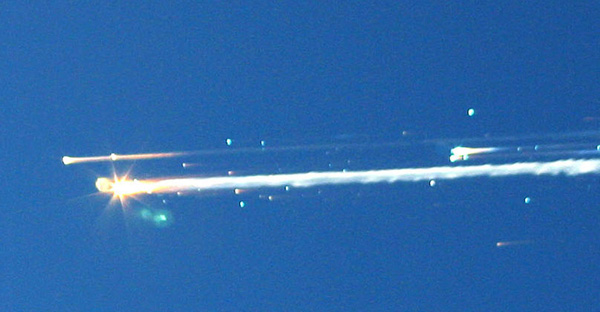On the morning of February 1st, 2003, the Space Shuttle Columbia was set to return from it’s 28th mission, STS-107. At 7:59 AM Central time the orbiter disintegrated on re-entry due to damage it had sustained on its left wing during launch on January 16th.
In this article, I tell the story from my perspective. As best I can after 15 years, anyway.
This was a strange day for me. A Saturday, while I was still at the tail end of High School. My birthday was the day before, I had just turned 18. I was awakened at about my normal time of way-too-late on a Saturday morning. I can’t recall exactly what had happened, but it seems like right as I woke up my family was shouting upstairs telling me that something bad had happened and I should tune the TV to a news station as soon as I could.
I don’t think I even had to – when I would wake up back then, I would normally channel surf to see what I might want to watch, or catch up on things. I believe I had already started this when I saw it about the same time they were alerting me – the distinctive image of a pure blue sky, contrasted with the sprawling comet-like trails of something disintegrating.

Columbia disintegrates over Texas on the morning of Feburary 1st, 2003
That something was the Space Shuttle Columbia.
I don’t know what I thought, or felt, at that time. The memories seem to be gone, as happens over the years. Quite a bit would happen to me in the upcoming few years that would overshadow this event, but we won’t get into that here.
I didn’t have regular internet access at this time, so I actually lacked the ability to look up much information – I had to wait for it to come to me via news reports. I didn’t even realize there was an orbiter up there – news never made much of a care to mention Shuttle launches and without reliable reports and updates from the internet, something I take advantage of now, there wasn’t much else of a way for me, a kid at 17-18 in 2003, to really know what was going on in space, so, it was all news to me.
Of course, as the weeks moved into months we would all learn about the foam strike, something NASA had considered routine. We would see the video of the crew as re-entry began, joking, having fun, with no clue of what was going to happen. We would hear stories of how they grew up, lived, of other missions some of them flew.
The shuttle would be grounded for another 2 years while changes were made and options considered – eventually, it was decided to end the program, and that all but one mission would launch to the International Space Station – any other mission save for the final Hubble Servicing Mission, would be canceled.
The Shuttle was set to be retired in 2010 on order of President Bush, but one final mission in 2011, STS-135, was authorized by President Obama. Columbia was still the beginning of the end for the Space Shuttle program, regardless. The machine, as amazing as it was, was simply deemed too dangerous in practice to fly for any longer than we needed it to complete the International Space Station.
I hated to see it end, but as time passed, I would eventually get to read the details on the disaster, as well as Challenger, and grow to understand the flaws in the Space Shuttle, and the situations at NASA that helped these disasters actually happen.
Speaking of Challenger, as an odd aside I’ll leave you with, back when I was younger I did the math on the time between the Apollo 1 fire and the Challenger disaster – that was 19 years. I had thought as a kid, with the way things seem to happen in patterns that we might well have another disaster in space in 2005 – 19 years after Challenger.
I wasn’t totally wrong on that – just 2 years off. I don’t believe in such patterns being significant, of course, but it was a little creepy to think back on me being a kid thinking “something might go bad again” and sure enough it actually did.
The really sad thing is, some root elements of Challenger played a role in Columbia – namely, the idea of “creeping normalcy” with odd things – Solid Rocket Booster burn-through in Challenger, and foam strikes in Columbia – NASA had, for whatever reason, treated these rather risky situations as “normal” and “acceptable” when they shouldn’t have… but that’s another story for another time.
